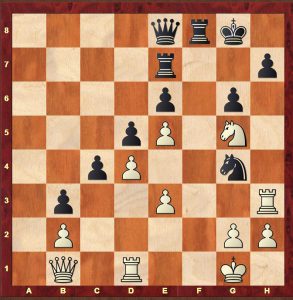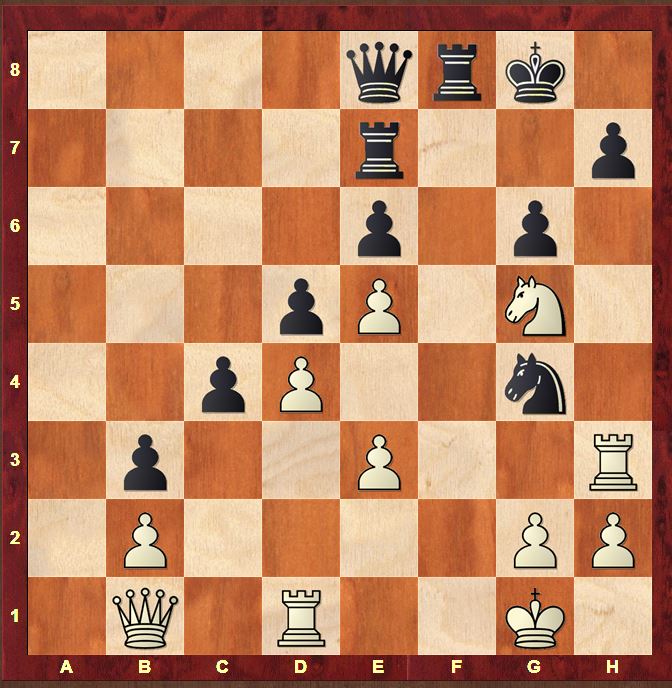A little while back I analysed the double-edged idea …c5-c4 in Queen’s Gambit Declined structures (https://matthewsadler.me.uk/chess-for-life/c5-c4-dogma/) and explained the conditions necessary to make this a viable plan for Black. At the recent Baku Olympiad, Nigel Short won a fascinating game in this structure against his young 2746-rated Chinese opponent:
Li,Chao b – Short,Nigel D
Baku Chess Olympiad 2016 Round 7
1.d4 Nf6 2.c4 e6 3.Nc3 Bb4 4.Nf3 b6 5.e3 Bb7 6.Bd3 0–0 7.Bd2 d5 8.cxd5 exd5 9.0–0 Nbd7 10.Rc1 a6 11.Ne5 Re8 12.f4 Nf8 13.Be1 c5 14.Bh4 c4 15.Bc2 b5
16.g4 Qb6 17.g5
17…Ne4 18.Nxe4 dxe4 19.Qe2 Bd5 20.Qg2 Qb7 21.f5 Nd7 22.Ng4 Kh8 23.Bg3 Rac8 24.Qh3 f6 25.g6
25…Nf8 26.Rf2 Rc6 27.Rcf1 a5 28.Rg2 a4 29.Rf4 c3 30.bxc3 Bxc3 31.Bh4 Qb6 32.gxh7 Re7 33.Ne5 fxe5 34.Bxe7 exf4 35.Bxf8 Bxd4
36.Qg4 Rc7 37.Qh5 f3 38.Rg4 Be5 39.Bc5 Qh6 40.Qe8+ Kxh7 41.Qxe5 Rxc5 42.Qe7 f2+ 43.Kg2
0–1
I hope to take a detailed look at this game in a future article as it has a number of unusual features. In particular I can only think of a couple of top-level examples in which White’s plan of g4-g5 has been played in this manner. In this article however, I would like to explore the value of Black’s queenside expansion with …c5-c4 and …b5-b4. How do the advantages Black accumulates on the queenside help him to deal with the gathering storm clouds on his kingside? An episode from the 3rd game of the 1930 Stahlberg-Bogolyubow match in Gothenburg illustrates this theme beautifully.
Stahlberg,Gideon – Bogoljubow,Efim
3rd match game, Gothenburg 1930
1.d4 d5 2.c4 e6 3.Nf3 c6 4.Nc3 Nf6 5.Bg5 Nbd7 6.cxd5 exd5 7.e3 Be7 8.Bd3 Ne4 9.Bf4 Ndf6 10.Qc2 0–0 11.0–0 Nd6 12.Bxd6 Bxd6 13.Ne5 c5 14.Rad1 Qe8 15.f4 c4 16.Bf5 b5 17.Rf3 Be6 18.Rh3 g6 19.Bxe6 fxe6 20.Nf3 b4 21.Nb1 a5 22.Ng5 Ra7 23.Nd2 a4 24.Ndf3 b3 25.axb3 axb3 26.Qb1 Re7 27.Ne5 Bxe5 28.fxe5 Ng4

Threatening …Nf2 forking the 2 rooks. Black has a marked advantage on the queenside: his pawns on b3 and c4 provide fantastic outposts for Black pieces on a2 (rook or queen) and d3 (knight) after which the immobilised pawn on b2 comes under fire. He is also able to create an advanced passed pawn at will with …c4-c3. However, White also has his trumps on the kingside. First of all, the pawn on e5 provides a strong outpost on f6 for a White rook and also chases away the Black knight on f6 from the defence of the kingside. Secondly, White’s knight on g5 is a very strong piece, attacking both e6 and h7.
In the game Stahlberg lost after the timid
29.Rf1 Rf5
29…Rxf1+ 30.Qxf1 Ra7 was simple and strong. Either …Qa8 or …c3 (or both) are coming! For example, 31.Rf3 c3. The text was also good enough however:
30.Rxf5 gxf5 31.e4 dxe4 32.Rc3 Rd7 33.Rxc4 Nxe5 34.Nxe4 Qd8 35.Nf6+ Qxf6 36.dxe5 Qd8 37.Rc1 Rd2 38.Qa1 Kf7 39.Qa7+ Kg6 40.h4 Qxh4 41.Qa8 Qd4+ 42.Kh1 Qxe5 43.Qg8+ Kh6 44.Rg1 Qf6 45.Qg3 Qg5
0–1
29.Rg3 was suggested by Soloviov as an improvement and this is where I started to analyse.
Black’s only way to fight for the advantage is 29…Nf2
a) 29…Nh6 30.Rh3 forces a repetition with 30…Ng4 as 30…Nf5 31.g4 is very unpleasant.
b) 29…h5
interested me for a while…
b1) 30.h3 Nf2
I didn’t think the inclusion of …h5 and h3 helped Black at all: for example, it relieves White’s back-rank problems by giving his king a ready-made escape square on h2. However, Komodo finds a sneaky way of making use of …h5!
31.Rd2 h4
Like that! In this way, Black neutralises any White pressure on the f-file.
32.Rf3 Rxf3 33.gxf3 Nd3 looks good for Black
b2) 30.e4
is a better move. One of the nice features of this move is that it allows the White rook on g3 to cover the c3 square. Black no longer has any surprise …c3 breaks creating a dangerous passed b-pawn. For this reason, Black does better to maintain the pace of his play and to keep on harrying White with 29…Nf2.
30.Rf1
We now have 2 alternatives. Soloviov analysed
a) 30…Nd3
Establishing the knight on the excellent outpost provided by Black’s advanced c-pawn.
31.Rf6
exploiting the outpost on f6 with an attack for White. This is a collision of advantages: White on the kingside, Black on the queenside! The most obvious threat is Rgf3 when the rook on f8 has nowhere to go. Black has 2 possibilities: my line, and Stockfish’s main line. We’ll start with my idea:
a1) 31…Qa8
This felt like the best square for the queen on the a-file: Black introduces the threat of …Qa2 while keeping touch with the rook on f8 (so Rxf8+ can be met by …Qxf8) and also allows the switch …Ra7 threatening …Ra1. White has 2 dangerous ways to continue the attack:
a11) 32.Rgf3
Black has to be very careful now as White has managed to bring his rook on g3 back into the game with tempo. The rook can now help to deal with any back-rank threats via Rf1. Note that Rf1 frees a path to the kingside for the White queen via d1–f3/g4.
32…Rxf6
32…Rfe8 33.Rf1 Qa2 34.Qd1 is a dramatic turnaround
33.exf6 Rf7
A very important concept which we will see many times in the coming variations. This type of idea is only possible due to the queenside advantages that Black has built up in the preceding moves. Black is able to give up material on the kingside to exchange off White’s most dangerous pieces (in this case, the knight on g5) because Black’s enormous queenside space advantage, his fantastic knight on d3 and his threats against the b2 pawn will give him dangerous compensation. In other words, Black’s queenside plusses stretch the boundaries of his defensive possibilities on the kingside.
I was extremely optimistic about this for Black, but it seems to be very murky!
34.Nxf7 Kxf7 35.Rf1
I suddenly realised this is possible even in this position. Black’s threat of …Qa2 is neutralised which means that the next source of Black activity is hard to imagine. I zoomed back now to extreme pessimism but bizarrely Komodo kept the faith claiming 0.00. His moves however are not easy to understand, let alone find! And when you start playing through his lines, the sneaky engine changes his mind and gives White an advantage!
35.Rh3 h5 36.g4
was the only line I was considering at the start
36…Qa2 37.Qf1
37.Qd1 Qxb2 38.gxh5 Qf2+ 39.Kh1 Qf5 wins
37…Qxb2 38.gxh5 Qf2+ 39.Qxf2 Nxf2 40.hxg6+ Kxg6 41.Kxf2 b2 42.f7 Kxf7 43.Rh7+ Kf6 44.Rb7 c3 wins
35…h6
Komodo’s recommendation
35…Qa2 36.Qxa2 (36.Qd1 intending Qg4–g3 is also very strong according to Komodo, but the text is simple enough.) 36…bxa2 37.Ra1 Nb4 38.Kf2
36.g3
Giving the king an escape square and preparing to move the queen to the kingside with Qd1–g4
36…Qa2 37.Qxa2 bxa2 38.Ra1 Nb4 39.Kf2 Kxf6 40.Ke2 Kf5 41.Rf1+ Kg4 42.Kd2 Kh3 43.Ra1 Kxh2 44.Kc3 Nd3 45.Rxa2 Kxg3 46.Ra6
is best play according to Komodo. It’s clear however that White is calling the shots after 35.Rf1 whatever the objective verdict on the position should be.
a12) 32.Qf1
Keeping the possibility open of using the rook on g3, for example with Nxh7 sacrifices. In practice however, Nxh7 never seems to lead to more than a perpetual so it’s not as strong a threat as it seems. Lots of ideas now for Black:
a121) 32…Ra7
Doesn’t threaten …Ra1 (due to Rxf8+) but does threaten …Rxf6 & …Ra1
33.h4
Covering the threat of …Rxf6 by making some room for the king on h2 while also preparing h5. This is very dangerous for Black;
a122) 32…Rxf6 33.exf6 Rf7 34.Nxf7 Kxf7 35.Rh3 h5 36.g4
made me nervous: White has a few extra tempi compared to other lines we have seen earlier. Komodo reckons however that a draw can be held. As you can see though, although Black’s moves are not difficult to guess, it’s not easy for Black in a practical game to evaluate whether he’s being mated or not!
36…c3 37.gxh5 g5 38.Qxd3 Qa1+ 39.Kg2 Qxb2+ 40.Kg3 Qc2 41.Qb5 Qd1
with perpetual;
a123) 32…c3
was my big hope for quite a few tube journeys! In the end though, I cottoned onto White’s best idea.
a1231) 33.Qxd3 Qa1+ 34.Kf2 Qxb2+ 35.Kf3 Qc2
is the lovely idea, covering everything;
a1232) 33.Nxh7 Rxh7 34.Rfxg6+
This didn’t occur to me: it’s Komodo’s find. 34.Qxd3 Qa1+ 35.Kf2 Qxb2+ 36.Kf3 Qc2 37.Rgxg6+ Rg7 wins for Black
34…Kh8 35.Rf6
is Komodo’s best shot with
35…Nf2 36.Rgf3 Rxf6 37.Rxf6 Kg8 38.Rxf2 c2
as a Black advantage. It’s all academic however as White has a much stronger continuation.
A1233) 33.Rgf3
The power of this move is that White activates his rook on g3 as a defensive unit with tempo: the rook can now retreat to f1 to cover any Black attempts to queen his pawn. Makes you wonder why White put it on h3 in the first place!
33…Rc8
I was again very positive about this for a while. However, White can cross Black’s plans very effectively.
33…Rfe8 34.Qxd3 c2 35.Rf1 is an example of the value of bringing the rook on g3 into play as a defensive unit.
34.bxc3
Makes it just that little bit harder for Black to make a queen. The knight on d3 is still hanging too while the rook on c8 cannot leave the back rank.
34.Qxd3 cxb2 35.Rxg6+ Kh8
I couldn’t see anything for White here and that seems to be correct
36.Rgf6 Rc1+ 37.Kf2 b1Q
covers h7!
38.Rf8+ Qxf8 39.Rxf8+ Kg7 wins
34…b2 35.Qxd3 Rxc3 36.Qxc3 b1Q+ 37.Rf1
My line which I thought was very good for White. Komodo gives +4! Nxe6 is coming!
37…Qb6 38.Qc2
And now Rxg6+ or Qf2!
38…Qe8 39.Qf2 Qbb8 40.Qh4
is a picturesque position. 2 queens just aren’t enough: Qh6 is one of the things threatened!;
a124) 32…Nxb2
is Komodo’s route to a draw. It looks mental to take the knight away from its glorious square just to take a pawn. However, once you combine it with other themes we have seen already (for example giving up the exchange after …Rxf6, exf6 …Rf7) then you start to understand why it can make sense.
a1241) 33.Nxh7 Rxh7 34.Rfxg6+ Kh8 35.Rf6 Re8
was my hope, However, Komodo finds an amazing number of ways to the draw!
35…Rg8 36.Rxg8+ Kxg8 37.Rg6+ Rg7 38.Rxg7+ Kxg7 39.Qf6+ is a draw
36.Rgf3 is the good old human way!
36.h3; 36.Rff3; 36.Rgg6 are all 0.00!
36…Rg8 37.Rf8 Qa3 38.Rxg8+ Kxg8 39.Rg3+
a1242) 33.Rgf3 Rxf6 34.exf6 Rf7
This idea again …Nxb2 has improved the situation on the queenside still further so it’s a very reasonable option in this position.
35.Nxf7 Kxf7 36.Rh3 h5 37.g4 Nd3 38.gxh5 gxh5 39.Rg3 Qa2
Covers g2! 39…b2 40.Rg7+ Kf8 41.Rg8+
41…Kxg8 42.Qg2+ mates
40.Rg2 b2 41.Rg7+ Kf8 42.Rg8+ Kf7 43.Rg7+ Kf8 44.Rg8+
is a draw!
a1243) 33.h4 Nd3 34.h5 Rxf6 35.exf6
35.Qxf6 Qf8
35…Rf7
We should definitely know this one by now!
a12431) 36.Nxh7 Rxh7
36…b2 37.hxg6 Qa1 38.gxf7+ Kxh7 39.Rg7+ Kh6 40.f8Q Qxf1+ 41.Kh2
37.hxg6 Rh5
is Black’s most elegant way to parry this idea. 37…Rh6 38.g7 Kf7 39.g8Q+ Qxg8 40.Rxg8 Kxg8 41.Qf3 Kf7 was my first try and is also good enough
38.g7 Rf5
a12432) 36.hxg6 hxg6 37.Nxe6
37.Rh3 b2 38.Rh7 Qa1 (38…Rxh7 39.f7+) 39.Rxf7 Qxf1+ 40.Kh2 Qxf6
37…b2 38.Rxg6+ Kh7 39.Qf5 b1Q+ 40.Kh2
I thought this was completely winning for White! I was completely wrong!
40…Qab8+ 41.Nf4
41.Rg3+ Kh8. Rh3+ isn’t possible as the rook is pinned!
41…Nxf4 42.Rg7+ Kh8
Once again, the queen on b1 covers h7 and the queen on b1 is covered by 40…Qab8+!
a12433) 36.Nxf7 Kxf7 37.hxg6+ hxg6 38.Rh3 b2 39.Rh7+ Kg8 40.Rg7+
40.Re7 Kf8
40.Rd7 Qb8 Threatens …b1(Q) and also stops the White king from moving out to h2!
40…Kf8 41.Rh7 Qa1 42.Rh8+ Kf7 43.Rh7+ Kg8 44.f7+ Kxh7 45.f8Q b1Q 46.Qe7+
is Komodo’s best play with a draw
a2) 31…h6
was recommended by Stockfish. It looked too risky to me, but Stockfish keeps it all together!
32.Nf3
32.Rgf3 hxg5 33.Rxf8+ Qxf8 34.Rxf8+ Kxf8 is pretty promising for Black: b2 is a huge target!
32…Rxf6 33.exf6 Ra7 34.Ne5 g5 35.h4
35.Rf3
is Komodo’s alternative after which he also ends up with equality.
35…Nxe5 36.dxe5 g4 37.f7+ (37.Rf4 Qh5) 37…Rxf7 38.Qg6+ Kf8 39.Qxh6+ Kg8 40.Qg6+ Kf8 41.Rf6 Rxf6 42.Qxf6+ Qf7 43.Qd8+ Kg7 44.Qg5+ Qg6 45.Qe7+ is the Komodo draw
35…Qh5 36.hxg5 hxg5 37.f7+
37.Nxd3 cxd3 38.Qxd3 Ra1+ 39.Kf2 g4 is also equal though it looks very tricky for White!
37…Rxf7 38.Nxf7 Kxf7
is equal according to Stockfish and Komodo.
My conclusion was that only a lunatic could look forward to playing 30…Nd3! However, the theme of Black giving up material to eliminate White’s best attacking piece – the knight on g5 – in order to be able to exploit Black’s queenside advantages thereafter (which we first saw in the line 30…Nd3 31.Rf6 Qa8 32.Rgf3 Rxf6 33.exf6 Rf7) brought me on to another idea:
b) 30…Ne4
My favourite line. Komodo takes a while to appreciate it properly. Black is willing to give up a pawn to negate White’s kingside play by exchanging White’s most dangerous attacking piece.
31.Rxf8+
31.Nxe4 dxe4 (31…Rxf1+ 32.Qxf1 dxe4 33.Qxc4) 32.Qxe4 (32.Rxf8+ –> 31.Rxf8+) 32…Rxf1+ 33.Kxf1 c3 34.bxc3 b2 wins
31…Qxf8 32.Rf3
32.Nxe4 dxe4 33.Qxe4
33.h4 was a favourite of Komodo’s for a while, but I couldn’t understand that: Black just keeps on going! 33…Rf7 34.h5 Rf1+ 35.Qxf1 Qxf1+ 36.Kxf1 c3 Another lovely illustration of the isolation of the rook on g3!
33…Rf7
33…c3 34.Rf3 Qb8 35.bxc3 b2 36.Rf1 Ra7 37.Rb1 Ra1 38.Kf2 Rxb1 39.Qxb1 Qb3 was another one of my lines and is also very strong. Komodo recommends 40.Ke2 Qxc3 41.Kd1 but it’s hard to believe that’s going to get anywhere
34.Rf3 Rxf3 35.gxf3 c3 36.bxc3 b2 37.Kf2 Qa3
simply wins as White doesn’t have perpetual
38.Kg3
38.Qc6 b1Q 39.Qe8+ (39.Qxe6+ Kf8 40.Qf6+ Ke8 The king escapes to the queenside) 39…Qf8
38…Qa1 39.Qc6 Kg7
The key move: 39…b1Q 40.Qe8+ is drawn.
40.Qd7+ Kh6 41.Qe7 Qg1+ 42.Kh3 Qg5 43.Qf8+ Kh5
Black will force the b-pawn home with …Qf5+.
32…Qc8 33.Nxe4 dxe4
Now White has 2 ways to hold the draw (uncomfortably)
b1) 34.Rf1 c3 35.bxc3 Qxc3 36.Qxe4 Rf7 37.Qa8+ Kg7 38.Rxf7+ Kxf7 39.Qf3+ Kg8 40.h3
is drawn according to Komodo (and this was my feeling too) It’s too hard for Black to queen his pawn and keep White’s queen under wraps.
40…Qc8 41.Qf1 b2 42.Qb5 Qc1+ 43.Kh2 b1Q 44.Qe8+ Kg7 45.Qe7+
is a draw by perpetual
b2) 34.Qxe4 c3 35.bxc3 b2 36.Qc2 Qb8 37.Rf1 Ra7 38.Rb1 Ra1 39.h3 Rxb1+ 40.Qxb1 Qb3 41.Kh2
This is a better version of this line: White’s king is safe and out of trouble which means that perpetual attempts succeed.
41…Kg7
41…Qxc3 42.Qa2
42.c4 Qc3 43.Qf1
and perpetual follows
So both lines seem to lead to a draw, but It’s clear that 30…Ne4 is a much better idea than 30…Nd3: Black gets very good practical chances with virtually no risk.
After analysing these variations, I suddenly understood that Black had a much better idea on the 28th move. Can you spot it too? Yes, that’s right: 28…Ne4 immediately! Get rid of that knight on g5 before White has a chance to get his rook on h3 back into play!
29.Nxe4 dxe4 30.Qxe4 c3 31.bxc3 Qb5
is super-strong. Black is threatening both …b2 and …Ref7. A sample line:
32.Rb1 Ref7 33.Rf3 Rxf3 34.gxf3 Qe2 35.f4 Rf7
followed by …Ra7–a2.
In conclusion, Black’s queenside advantages are an integral part of his defensive strategy on the kingside. In particular, the concept of giving up material on the kingside – a pawn (as with …Ne4) or the exchange (as with …Rf7) – to remove White’s most important attacking piece(s) and thus win time for Black to pursue the conversion of his queenside plusses is extremely important.



